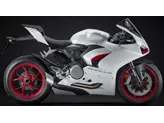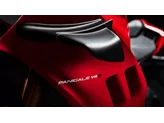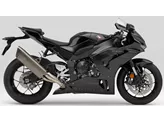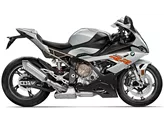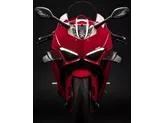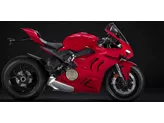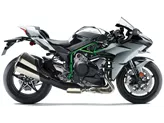BMW S 1000 RR 2016 vs. Ducati Panigale V4 2018

BMW S 1000 RR 2016

Ducati Panigale V4 2018
Overview - BMW S 1000 RR 2016 vs Ducati Panigale V4 2018
The BMW S 1000 RR model year 2016 and the Ducati Panigale V4 model year 2018 are both high-performance supersport motorcycles that offer impressive power and advanced features.
Starting with the engine and drive train, the BMW S 1000 RR 2016 is equipped with an in-line four-cylinder engine with a displacement of 999cc. It produces 199 horsepower and 113 Nm of torque. On the other hand, the Ducati Panigale V4 2018 features a V4 engine with a displacement of 1103cc, delivering 214 horsepower and 124 Nm of torque. The Ducati engine has a slightly larger bore and stroke, resulting in higher power and torque figures compared to the BMW.
In terms of suspension, the BMW S 1000 RR 2016 features a telescopic fork at the front and a swing arm suspension at the rear. The Ducati Panigale V4 2018, on the other hand, is equipped with an upside-down telescopic fork at the front and a single swing arm suspension at the rear. Both motorcycles have aluminum frames, providing a lightweight and rigid chassis.

BMW S 1000 RR 2016
When it comes to braking, both bikes have double disk brakes at the front. However, the Ducati Panigale V4 2018 features radial and monoblock technology, which enhances braking performance and provides better control compared to the BMW S 1000 RR 2016.
In terms of dimensions and weights, the Ducati Panigale V4 2018 has a slightly larger wheelbase of 1469mm compared to the 1425mm of the BMW S 1000 RR 2016. The seat height of the Ducati is also slightly higher at 830mm compared to the 815mm of the BMW. The Ducati is slightly lighter with a kerb weight of 198kg, while the BMW weighs 204kg (both with ABS). The BMW has a larger fuel tank capacity of 17.5 liters compared to the 16 liters of the Ducati.

Ducati Panigale V4 2018
Now, let's discuss the strengths and weaknesses of each motorcycle. The BMW S 1000 RR 2016 has a very powerful engine, providing exhilarating acceleration. It also offers a comfortable seating position, making it suitable for longer rides. Additionally, it features an excellent shift assistant, allowing for smooth and quick gear changes. However, some riders may find it somewhat sluggish in curves.
On the other hand, the Ducati Panigale V4 2018 boasts a powerful engine with great manners and charisma. It offers a pleasant upper body position compared to other supersport bikes, ensuring rider comfort. The V4 engine produces a powerful but not intrusive sound, adding to the overall riding experience. The Ducati also provides good wind protection. However, the seat can get warm, especially in city traffic, and the engine/clutch may feel a little rough in tight hairpin bends.
In conclusion, both the BMW S 1000 RR 2016 and the Ducati Panigale V4 2018 are impressive supersport motorcycles with their unique strengths and weaknesses. The BMW offers a powerful engine and comfortable seating position, while the Ducati excels in terms of engine power, upper body position, and wind protection. Ultimately, the choice between the two will depend on the rider's preferences and priorities.
Technical Specifications BMW S 1000 RR 2016 compared to Ducati Panigale V4 2018
Pros and Cons in comparison
Pros and Cons in comparison
BMW S 1000 RR 2016

The S 1000 RR is the universal talent among the superbikes - you sit on it and feel comfortable straight away. Although it seems a bit nervous in comparison in terms of chassis and stability. However, it converts this into pleasantly easy handling and impresses with its enormous engine power. The front wheel is indeed particularly light and has to be calmed by the steering damper. An incredibly sporty and at the same time comfortable feature is the shift assistant for upshifting and downshifting - this brings calm to the chassis and you can fully concentrate on driving.
Ducati Panigale V4 2018

The Panigale has become much more accessible in the 2018 V4 version than before. The engine, in combination with the electronics package, is still not as flawless and sterile as an inline four, but in practice it is a real blessing for Ducatisti - and a positive surprise for riders of other brands. The Panigale V4 also surprised with tolerable riding comfort on the country road and a pleasant level of stability. Progress here was clearly in the right direction. The new V4 is stronger and faster but also easier and more pleasant to ride.
Price Comparison Avarage Market Price BMW S 1000 RR vs Ducati Panigale V4
There are a few key differences between a BMW S 1000 RR 2016 and a Ducati Panigale V4 2018. In terms of price, the actual average price of a Ducati Panigale V4 2018 is about 33% higher. A BMW S 1000 RR 2016 experiences a loss of 10 USD in one year and 470 USD in two years of ownership. This is offset by a loss of 1,130 USD and 2,480 USD for a Ducati Panigale V4 2018. Compared to Ducati Panigale V4 2018 there are more BMW S 1000 RR 2016 bikes available on the 1000PS.de Marketplace, specifically 7 compared to 5. It takes less time to sell a BMW S 1000 RR with 69 days compared to 91 days for a Ducati Panigale V4. Since model year 2010 1000PS.de editors have written 135 reviews for the BMW S 1000 RR and 18 reviews for the Ducati Panigale V4 since model year 2018. The first review for the BMW S 1000 RR was published on 4/16/2008 and now has more than 4,000 views. This compares to more than 131,500 views for the first review on Ducati Panigale V4 published on 11/5/2017.


